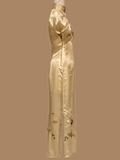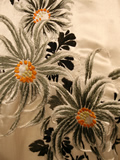Overview of the Qi Pao
Qi pao is a relatively new women’s clothing form that derived from the Qing Dynasty women's robe. At first, it was worn by women of higher social status, but was gradually popularized by the general public. Today, the qi pao business is an important part of China’s clothing industry. It is a product of a mixture of eastern and western culture. The chrysanthemum qi pao in the NowesArk Collection is 51 inches long from collar to the bottom of the hem, with a bust measurement of 35 inches, a waist of 26 inches, and a hip of 36 inches. According to a recent study of Chinese body measurements by Alvanon, a clothing design consulting company that has the world's largest database human body measurements, the average Chinese female has a height of 5’4”, with a chest of 31 inches, waist of 28 inches and low hip of 35 inches. According to these measurements, this qi pao would fit a woman of average height and weight in China.
The collar (领 ling)
The earliest forms of qi pao had circle collars which did not require buttoning when putting on. In order for it to be suitable for women with different shapes, a collar with diverse shapes was developed. The most common variations included low collar, V-shaped collar and shoe-shaped collar. The shape of this collar, as seen below in Figure 1, is not one of these common shapes. Rather, it has a form known as a Shanghai collar which is a mixture of square collar and circle collar. Scholars suggest that the Shanghai collar represents the ancient Chinese wisdom “circle in square while square in circle.” In addition this form flatters women with different face shapes.
Figure 1: Collar Detail |
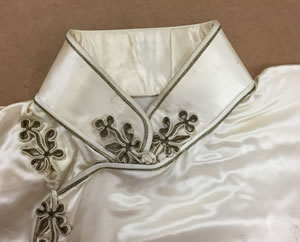 |
The front piece (襟 jin) and the Sleeves (袖 xiu)
The front piece of qi pao refers to the front side of the top excluding sleeves. There are approximately 10 common designs of the front piece, varying in shape, length, and width among them. This qi pao, which has a curved front piece, belongs to one of them. The curved shape avoids a sense of rigidity and the the “S” shaped curve creates a bigger opening when women put on the garment. The sleeves are a common short size, popular in summer months, that wrap the shoulders.
Hem (裙摆 qunbai) and slits (开衩 kaicha)
This garment has a high-waisted structure which emphasizes a woman’s curves. This qi pao has a slit of measuring 16.5 inches, reaching to the knees on both sides. The slits make it easier for a woman to walk with a normal gait.
Frog buttons (盘扣 pankou)
Frog buttons, usually made of winding strip cloth and sometimes with silver metals inside, are widely used in the making of qi pao to hold the front piece in place. Different winding styles create different shapes of buttons, most of which are flowers and Chinese knots. This garment has plum flower-shaped symmetric frog buttons, with a layer of folded silver foil to support the cloth. Most of the time, when young women make frog buttons for themselves they attempt to convey a longing for love with the shape of flowers while older women wear frog buttons made to resemble Chinese characters, such as “Fu”, “Shou”, to pray for happiness and longevity, respectively. Therefore, the frog buttons on this garment, which can ben seen in Figure 1 above, indicate that it was made for young and unmarried woman.
Texture, color and embroidery (刺绣 cixiu)
The garment is made of silk satin, one of the most common materials used for qi pao. It is well known for its smooth touch and brilliant luster and the relatively thin fabric is light and air-permeable making it a popular choice for summer qi pao. The silk is dyed in cream color, which falls into the category of shades of yellow. The whole yellow category is considered the most elegant in China. Between Song Dynasty and Qing Dynasty, only the emperor had the right to wear yellow clothing and own yellow objects. Although the proscription has been abandoned since the Republic of China was founded, yellow is still considered as the representation of luxury and power.
There are three pieces of embroidery on it, one on the top left of the front (as illustration 5 shows), one on the bottom right of the front, and another on the bottom of the back. The appearance of these pieces are basically the same, only varying slightly in color and length of the chrysanthemums.
Each piece of embroidery consists of six spider chrysanthemums connected by leaves. Four of them are grouped closer together, two larger and two smaller, while the two remaining are further apart. The petals are embroidered in dark green and white silk floss, with yellow and orange silk floss used to stitch the carpels. The branches and leaves connect the flowers. A chrysanthemum pattern is a common decoration on qi pao, mainly because it symbolizes a Chinese favorite quality of an unyielding spirit, according to most scholars including 徐东 Xu Dong in 旗袍 Chi-pao. The embroidery was skillfully done, as can be seen in the even stitches on the outside and the careful ones on the inside. Figures 2 and 3 below show the embroidery in detail.
Figure 2: Embroidery Detail |
Figure 3: Inside Embroidery Detail |
 |
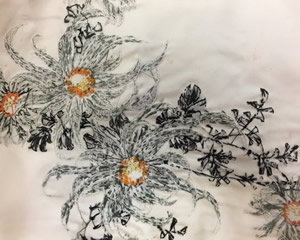 |
Lacing (镶边 xiangbian), edging (滚边 gunbian), and shaping darts (省道 shengdao)
Lacing and edging are often used together to protect the edge of garments, especially those made from silk and cotton because they protect encompass threads. Edging refers to using a strip of cloth to wrap the edge to enhance the smoothness of the edge of collars and cuffs. Lacing is the layer inserted inside the edging to beautify it. In this case, as Figure 5 below shows, silver metal is used to stiffen and beautify the edging. This garment has edging around all the edges made from self-fabric which enhances its' luxury and elegance.
Darting is a technique to excise excess cloth, in order to make the clothes fit more closely to a three-dimensional human body. Darts helped to transform qi pao from a two-dimensional loosely fitting garment to a three dimensional one that fits tighter to the body. This qi pao has both bust darts and front waist darts creating a form-fitting shape.
Figure 5: Detail of Lacing and Edging |
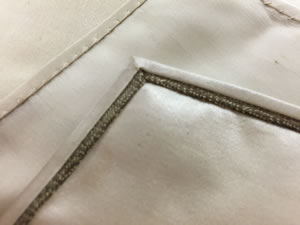 |
Traces of Modification
In appearance, this garment is the same as traditional qi pao. However it is modified making it more convenient to put on. Frog buttons were originally used on qi pao, but frog buttons have two weaknesses. Because frogs are made of strip of cloth, which is softer than plastic or metal, the buttonhole and the knot do not always very well, so it takes time to button them. Second, frog buttons are relatively loose and easy to open. Therefore, the snap fasteners and hooks complement frog buttons to keep the cloth in place, providing security and convenience.
The structure of qi pao became tighter in its later development making it more difficult to put on. Therefore, a hidden metal zipper on the right side gives a woman a larger opening for putting it on. The maker of this qi pao did very well in terms of details -- even the hidden metal zipper has a delicate ring-shaped zipper pull improving the overall quality.
A Hypothesis of the Garment’s Place of Production
There is no label that indicates place of production on the garment, but a hypothesis of where it was produced. This qi pao dates from the mid-20th century, so Shanghai can be ruled out as a production place, because during that time textile mills were forbidden to manufacture qi pao which was regarded as a symbol of Westernization. Western countries can also be excluded considering the length (ankle length) and the hand-made embroidery are not the styles that belong to western countries.
Although qi pao in Hong Kong and Taiwan developed in a similar way, the social contexts of these two places contributed to the difference between Hong Kong qi pao and Taiwan qi pao. Numerous Chinese people migrated to Hong Kong and Taiwan from Shanghai, but government officials of Kuoming Tang tended to migrate to Taiwan, while families from the business sector preferred Hong Kong. The difference in immigrants created nuance in qi pao prevalent style. Women wearing qi pao in Taiwan were the wives and daughters of the officials, so they were not allowed to wear avant-garde ones. As a result, the popular styles in Taiwan were relatively conservative. The dresses were of mid-calf length or ankle length, and the patterns of which were mostly embroidered flowers or animals. Hong Kong immigrants, on the other hand, designed and wore innovative and adventurous designs. They favored qi pao of knee length with patterns other than flowers and brighter colors. Therefore, it is more likely that this qi pao was produced in Taiwan in the mid-20th century for a young women to wear during summer.
© Jiacheng Liu, Class of 2019
Drama 475.001, Spring 2016 Semester
University of North Carolina at Chapel Hill


